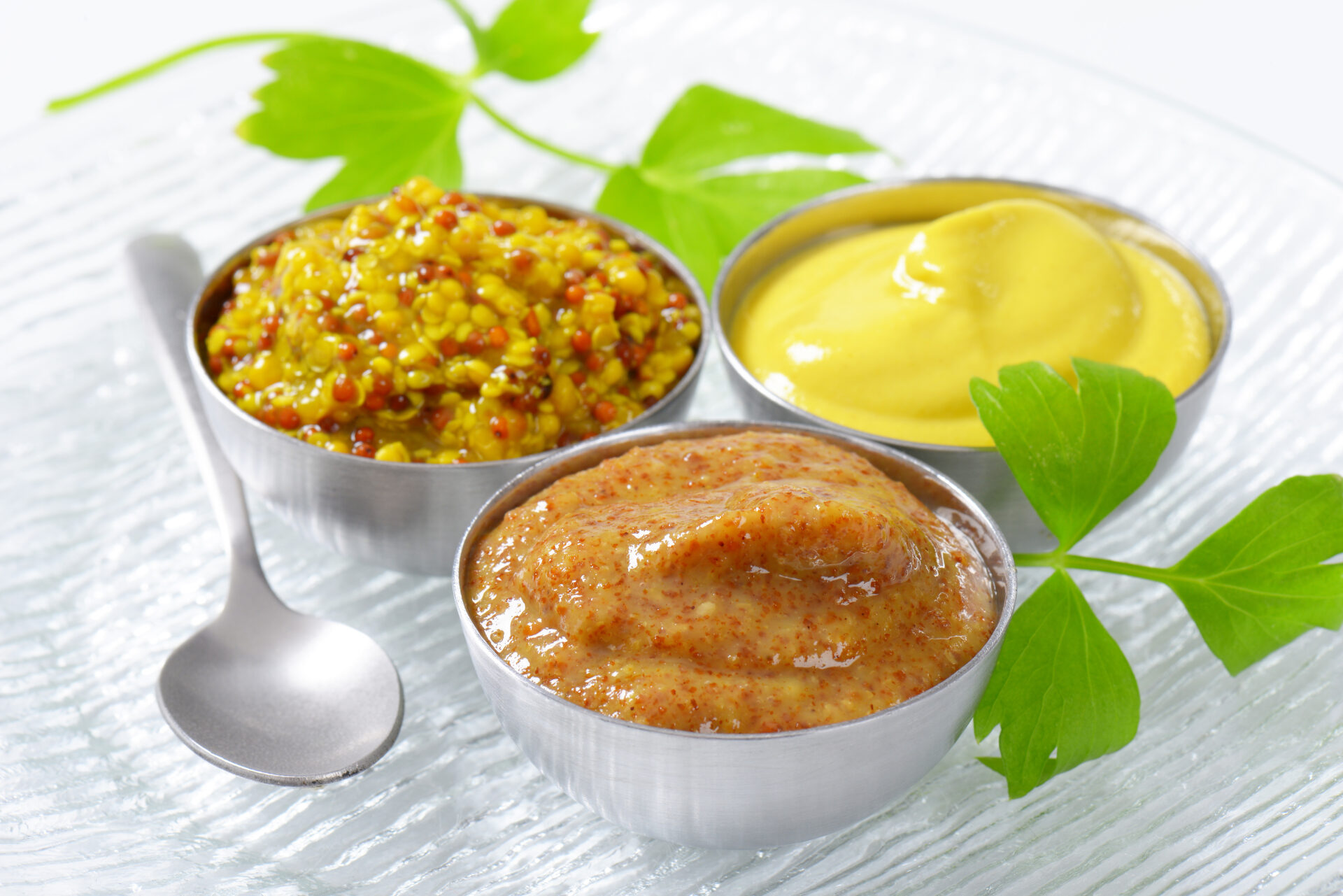And now, with thanks to Wikipedia, let’s look at what Mustard is, where it began, its many uses, how to make it, and how to cook with it.
Mustard is a condiment made from the seeds of a mustard plant (white/yellow mustard, Sinapis alba; brown mustard, Brassica juncea; or black mustard, Brassica nigra). It is one of the world’s most popular condiments.
Mustard is commonly paired with meats, vegetables and cheeses, especially as a condiment for sandwiches, hamburgers, corn dogs, and hot dogs. It is also used as an ingredient in many dressings, glazes, sauces, soups, and marinades. As a cream or as individual seeds, mustard is used as a condiment in the cuisine of India and Bangladesh, the Mediterranean, northern and southeastern Europe, Asia, the Americas, and Africa, making it one of the most popular and widely used spices and condiments in the world.
The whole, ground, cracked, or bruised mustard seeds are mixed with water, vinegar, lemon juice, wine, or other liquids, salt, and often other flavorings and spices, to create a paste or sauce ranging in color from bright yellow to dark brown. The seed itself has a strong, pungent, and somewhat bitter taste. The taste of mustard condiments ranges from sweet to spicy and the texture can range from smooth to grainy.
The English word “mustard” derives from the Anglo-Norman mustarde and Old French mostarde. (Modern French is moutarde.) The first element is ultimately from Latin mustum, (“must”, unfermented grape juice)—the condiment was originally prepared by making the ground seeds into a paste with must or verjuice. The second element comes also from Latin ardens, (hot, flaming). It was first attested in English in the late 13th century, though it was found as a surname a century earlier.
History
Archaeological excavations in the Indus Valley (Indian Subcontinent) have revealed that mustard was cultivated there. That civilization existed until about 1850 BCE.
The Romans were probably the first to experiment with the preparation of mustard as a condiment. They mixed unfermented grape juice (the must) with ground mustard seeds (called sinapis) to make “burning must”, mustum ardens—hence “must ard”. A recipe for mustard appears in De re coquinaria, the anonymously compiled Roman cookbook from the late fourth or early fifth century; the recipe calls for a mixture of ground mustard, pepper, caraway, lovage, grilled coriander seeds, dill, celery, thyme, oregano, onion, honey, vinegar, fish sauce, and oil, and was intended as a glaze for spit-roasted boar.
The Romans likely exported mustard seed to Gaul, and by the 10th century, monks of Saint-Germain-des-Prés in Paris absorbed the mustard-making knowledge of Romans and began their own production. The first appearance of mustard makers on the royal registers in Paris dates back to 1292. Dijon, France, became a recognized center for mustard making by the 13th century. The popularity of mustard in Dijon is evidenced by written accounts of guests consuming 320 litres of mustard creme in a single sitting at a gala held by the Duke of Burgundy in 1336. In 1877, one of the most famous Dijon mustard makers, Grey-Poupon, was established as a partnership between Maurice Grey, a mustard maker with a unique recipe containing white wine; and Auguste Poupon, his financial backer. Their success was aided by the introduction of the first automatic mustard-making machine. In 1937, Dijon mustard was granted an Appellation d’origine contrôlée. Due to its long tradition of mustard making, Dijon is regarded as the mustard capital of the world.
The use of mustard as a hot dog condiment is said to have been first seen in the US at the 1904 St. Louis World’s Fair, when the bright-yellow French’s mustard was introduced by the R.T. French Company.
Mustard is most often used at the table as a condiment on cold and hot meats. It is also used as an ingredient in mayonnaise, vinaigrette, marinades, and barbecue sauce. It is also a popular accompaniment to hot dogs, pretzels, and bratwurst. In the Netherlands and northern Belgium, it is commonly used to make mustard soup, which includes mustard, cream, parsley, garlic, and pieces of salted bacon. Mustard as an emulsifier can stabilize a mixture of two or more immiscible liquids, such as oil and water. Added to Hollandaise sauce, mustard can inhibit curdling.
Home preparation
You can easily try making your own mustard at home, and we have a simple recipe right HERE for you to try!
Common Mustard Styles
American/yellow mustard
The most commonly used mustard in the United States—and tied with Dijon in Canada—is American mustard sold as “yellow mustard” (although most prepared mustards are yellow) and commonly referred to as just “mustard”. A very mild prepared mustard colored bright yellow from turmeric powder, it was supposedly introduced in 1904 by George J. French as “cream salad mustard”. Yellow mustard is regularly used to top hot dogs, sandwiches, pretzels, and hamburgers. It is also an ingredient of many potato salads, barbecue sauces, and salad dressings. It is commonly referred to as “hot dog”, “ball park”, “American yellow”, “sunshine”, or “prepared” mustard for these applications. In Austria, it is called Amerikanischer Senf (American mustard), and is regarded as much milder than local varieties.
Spicy brown/deli-style mustard
Spicy brown mustard is also commonly used in the United States. The seeds are coarsely ground, giving it a speckled brownish-yellow appearance. In general, it is spicier than American mustard. Some “deli-style” mustard incorporates horseradish, which actually makes it a little spicier than spicy brown. A variety popular in Louisiana is called Creole mustard. Typically, Creole mustard is much coarser than spicy brown.
Beer mustard
Beer mustard, which uses beer instead of vinegar, allegedly originated in the 20th century somewhere in the United States Midwest and has remained a popular local condiment.
Whole-grain mustard
In whole-grain mustard, also known as granary mustard, the seeds are mixed whole with other ingredients. Different flavours and strengths can be achieved through different blends of mustard seed species. Groningen mustard is an example of a mustard with partially ground grains.
Honey mustard
Honey mustard is a blend of mustard and honey, typically mixed in a 1:1 ratio. It is commonly used both on sandwiches and as a dip for finger foods such as chicken fingers. It can also be combined with vinegar or olive oil to make a salad dressing.
Hot pepper mustard
Chili peppers of various strengths are used to make a variety of mustards more piquant than plain mustard. Peppers or hot sauce made from peppers are added to mustards of different base styles such as yellow mustard, brown mustard, or spirited mustards.
Fruit mustards
Fruit and mustard have been combined since the Lombard creation of mostarda di frutta in the 14th century. Large chunks of fruit preserved in a sweet, hot mustard syrup were served with meat and game, and were said to be a favorite of the Dukes of Milan. Traditional variations of fruit mustards include apple mustard (traditional in Mantua and very hot), quince mostarda (or mostarda vicentina, mild and with a jam-like appearance), and cherry mustard. In various areas of Italy, the term mostarda refers to sweet condiments made with fruit, vegetables, and mosto, grape juice that gets simmered until syrupy.
Hot mustard
The term “hot mustard” is used for mustards prepared to bring out the natural piquancy of the mustard seeds. This is enhanced by using pungent black or brown mustard seeds rather than the white mustard seeds used to make mild mustards.
Spirited mustards
Spirited mustards are made with alcoholic spirits. Variations include Arran mustards with whisky, brandied peach mustard, cognac mustard, Irish “pub” mustard with whiskey, and Jack Daniel’s mustard.
Cooking with Mustard
Along with using Mustard as a condiment, it is also a wonderful ingredient! We have pulled together a couple of great recipes that explore different ways that mustard can contribute to a finished fish dish.
Try our Dijon Baked Salmon recipe. Or this delicious Baked Mustard Crusted Sole with Asparagus recipe.
Armed with your new knowledge of this hard-working, international condiment, we hope you will add more mustard to your cooking and eating as you celebrate the coming Spring season and new beginnings.


No comments yet. Add the first comment